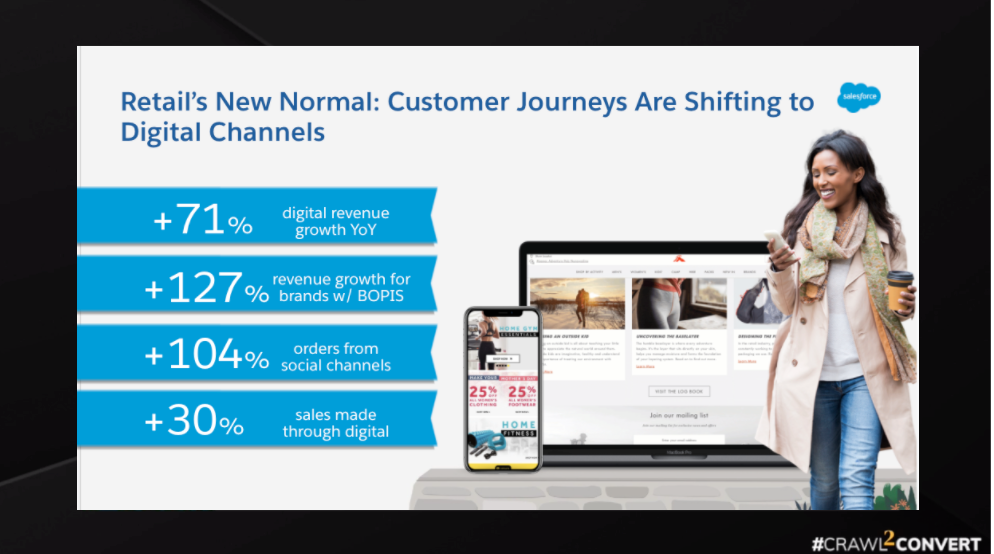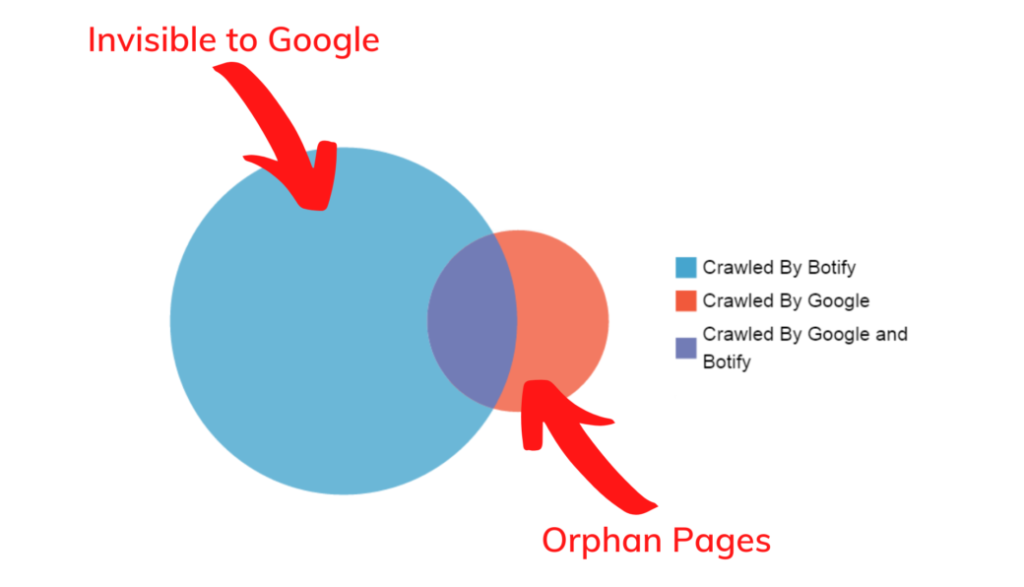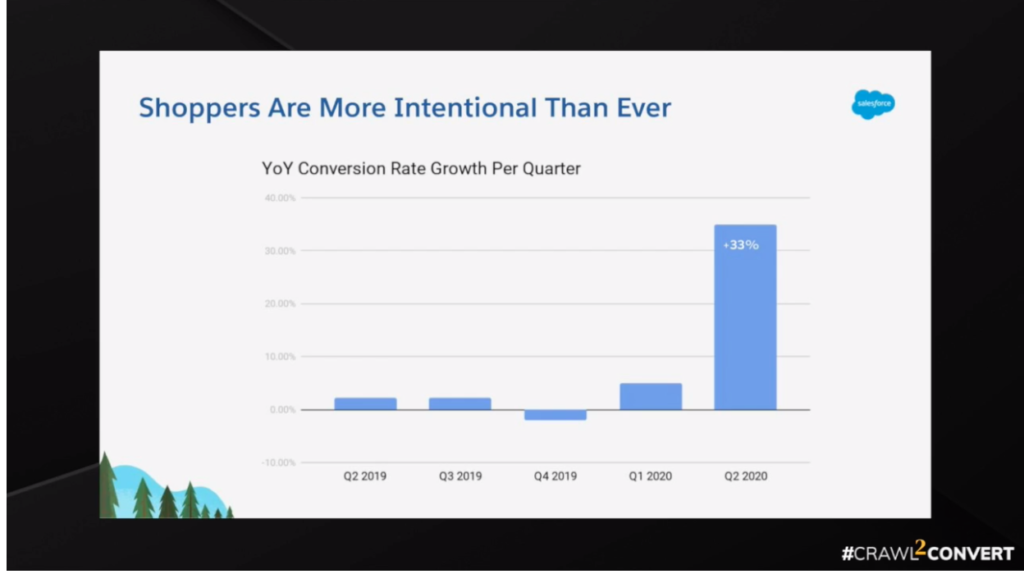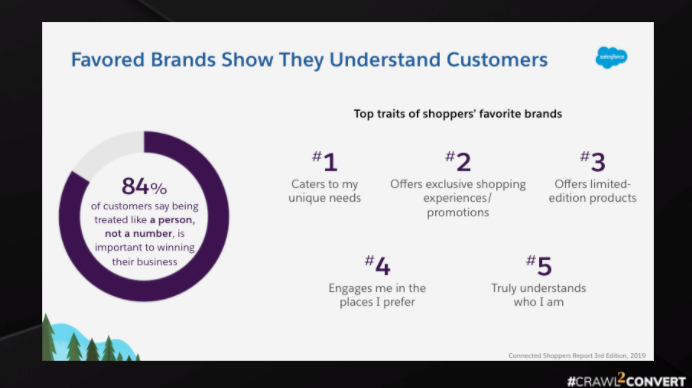There is no denying that 2020 created a fundamental shift in the way all consumers behave and transact online. E-Commerce was steadily gaining momentum and share of wallet over the last decade, but the pandemic, which has not only forced consumers into new daily routines, has also propelled digitally-dominant shopping behaviors.
While there’s a lot about 2020 we’d like to leave behind, its impact on the e-commerce industry shows signs of permanence. “Many consumers have either shopped online for the first time or shopped in new categories (i.e., groceries). Both the increase in new users and frequency of purchasing will have a lasting impact on retail,” said Cindy Liu, eMarketer senior forecasting analyst at Insider Intelligence.
During Botify’s annual virtual conference Crawl2Convert, retail industry experts Alex Drinker and Anne Marie Aviles from Salesforce shared key trends for the future of retail, holiday predictions, and what that means for the new normal of commerce. Let’s take a look at the top three trends, how the busiest holiday shopping weeks fared, what that means for 2021 and beyond, and how SEO plays a critical role in benefiting from these trends.


Trend #1: Doubling Down on Digital
The first trend shouldn’t come as a surprise, but it’s also never been more relevant.
Through its Commerce Cloud platform, Salesforce powers the online business of hundreds of leading brands within apparel, sportswear, beauty, and more, including Adidas, Under Armour, Ralph Lauren, Puma, Lancome, NYX Professional Makeup, Uniqlo, and Columbia. Because of this, Salesforce is able to analyze the behaviors of more than 1 billion shoppers from more than 34 countries. Combined with global surveys and shopping studies, Salesforce’s data set is both unique and robust.
According to their data, in Q2 2020, global digital revenue grew by an unprecedented 71% to the previous year, growth that continued even as physical storefronts around the world started to reopen, while 30% of all sales were made through digital channels.


Fast forward to Cyber Week during which projections were outpaced and records broken. “Total digital sales reached $270 billion globally… Overall digital commerce was up 36 percent globally and 29 percent in the U.S. year-over-year with a 22 percent increase in consumers who participated in Cyber Week this holiday season compared to 2019 as the pandemic pushed more consumers online.” Additionally, “online traffic increased by 28% on Tuesday and 18% Wednesday before Thanksgiving.”
With this surge, brands must ensure they remain relevant on the channels where their consumers are most active. According to Drinker, “the top channel is still your website, and you always have to remember to optimize your website so your pages can be discovered by engines and consumers throughout the journey.”
“The top channel is still your website, and you always have to remember to optimize your website so your pages can be discovered by engines and consumers throughout the journey.”
Alex Drinker, Global Leader, Retail Go-To-Market, Salesforce
Optimizing your website means more than plugging key terms on your category and product pages. Instead, you must understand your website’s technical health and whether or not your critical, revenue-driving pages are being found by search engines. If they aren’t, they will also not be discoverable by your prospective customers through organic search, giving your competitors a leg up.


Want to know what the search engines are seeing on your website and what they’re missing?
Botify’s LogAnalyzer enables just that and if you’re running your site on Salesforce Commerce Cloud, you’re in luck. Our recent partnership with Salesforce ensures that you can leverage the complete, unified data set necessary for unlocking the full potential of SEO – and that includes log file data!


Trend #2: Shoppers Are More Intentional
Shoppers are more intentional than ever – intent on buying – which means that brands must be prepared.
According to Aviles, “typically, when we see surges in online activity, conversion rates go down,” however this year, data shows otherwise. “People are doing more than just browsing, they are going through and making purchases. They are more intentional than ever before.”
“People are doing more than just browsing, they are going through and making purchases. They are more intentional than ever before.”
Ann Marie Aviles, Sr. Associate, Industry Strategy & Insights


She continued to say that instead of browsing for hours indoors in a mall, shoppers will plan ahead. “How? By doing their research. A recent study by Google showed that 88% of in-store purchases were preceded by online search. And in our own surveys, we found that the #1 most influential reason for shopper loyalty… was having the items that they need in stock. What does this mean? It means that your online information – like hours of operation, inventory availability, and delivery options – better be accurate.”


In fact, search query data reinforces that sentiment about merchandise availability.
“Searches for “who has” plus “in stock” were up over 8,000% year over year,” according to Google Data. “It’s a key indicator for marketers wondering how to market in a time of upheaval. From store hours to safety restrictions to learning how to work and teach at home, people turned to search.”
“From store hours to safety restrictions to learning how to work and teach at home, people turned to search.”
Think With Google, December 2020
With increased demand, and products coming in and out of stock quickly – especially during peak shopping seasons – marketers need a game plan. Instantly removing an out-of-stock product page can be harmful to your SEO.
In a post focused on seasonal SEO for e-commerce, Botify noted that “Every time you remove a page or a product, you create the potential for a black hole for your customers, one that will either see them bounce from your site, or worse, go to your competitor looking for something similar. This leads to a loss in potential revenue for your business.”
Instead, learn how to leverage traffic to those pages and retain a product’s value, even when it’s out of stock, while maintaining customer satisfaction.
Trend #3: Personalization as a Differentiator
With seemingly unlimited options, personalization becomes a main differentiator – and the third trend that is dominating e-commerce. In fact, according to a Salesforce survey of 10,000 consumers, the number one trait of their favorite brands was catering to their unique needs.


Brands have a wealth of data at their fingertips; data that provides insights into what their consumers’ wants and needs are; what dellights them and what creates friction. Search data is no exception. In fact, it’s a gold mine. To repeat the words of Shawn Huber, SEO Manager at T-Mobile, “Search is the greatest place to understand what people want. No one lies to their search bars. It’s a treasure trove of data you’re not going to get anywhere else.”
“Search is the greatest place to understand what people want. No one lies to their search bars. It’s a treasure trove of data you’re not going to get anywhere else.”
Shawn Huber, T-Mobile (during Botify webinar on algo updates & volatility in organic search)
Navigating search query data, however, isn’t black and white, but with the right tools and technology to tap into and leverage this data, brands can create more meaningful and rewarding experiences that turn searchers into customers. You can read more about searcher intent, the value of combining keyword data with additional search data for greater context, and how to use this intent data to develop a framework for creating relevant content.
SEO & The New Normal
Search engines are not only the most common starting point for a consumer’s interaction with a brand, but shoppers also turn to search engines repeatedly during and after their purchase. Search is heavily embedded in today’s shopping experience and as brands continue to adjust to the new normal and the acceleration of digital behaviors, an effective SEO strategy will be even more essential to stand out and drive long-term, sustainable traffic and revenue growth in 2021 and beyond.





